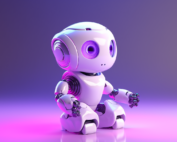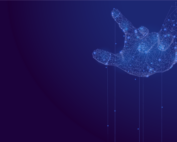Artificial intelligence (AI), robotics, and machine learning are automating jobs and bringing sweeping societal change. While this is not a sudden shift, the impact of this disruption is spreading to roles once considered “safe” from automation. We’re seeing automation move from the auto manufacturer’s floor to the legal office, the writer’s desk, the surgeon’s table and beyond.
The Luddite Fallacy
The thoug ht of job automation is a worrying thought for many people. The idea of losing a job to a computer or robot is obviously unsettling. But, while the Luddites (which I wrote about here) saw an impact on their livelihoods long – term, automation generally creat ed greater wealth and more jobs. This is commonly referred to as the ‘Luddite Fallacy’ — the belief that the technological disruption of employment is unique to the present, and will fracture society as we know it. Yet, time and again we see that while a pro cess may be turned over to machines, humans still play a large, and often more satisfying role.
Automation – ready Industry Sectors
It’s undeniable that automation and AI are making their way into our daily lives. Amazon Go is eliminating the need for cash iers, and self – driving vehicles won’t need truckers and cab drivers at their wheels. Artificial intelligence is beginning to diagnose disease, perform surgery, and even write film trailers.
On the face of it, the sectors most affected by automation are ma nufacturing, wholesale and retail, and transport and storage. Examples of retail exodus are not hard to find; in the U.K ., John Lewis, Sainsbury’s and Tesco all announced plans to reduce man power (collectively) by over 3,700 personnel in 2017 as the roles become centralised and automated . Furthermore, the U.K saw more than 15 shop closures a day across the country, and the number of new openings has now fallen to the lowest level in five years, according to a report that highlights the pressure on the ret ail sector.
In retail labour, Amazon has had a huge impact, with warehouse automation all but replacing traditional shipping and packing work that used to be carried out by people. On a typical Amazon order, employees will spend about a minute total takin g an item off the shelf, then boxing and shipping it. The rest of the work is done by robots and automated systems.
But nuanced human interactions are much harder processes to codify. While managing a machine via software is the norm, automating the deepe r “thinking” tasks is much more complex, and until now something that could really only be managed by humans.
But technology is now affecting those roles once considered “safe” from automation. The legal profession, once heavy with tradition and a lifetim e of experience, is slated for transformation via AI and eDiscovery platforms that can review and create contracts, raise red flags to spot potential fraud and other misconduct, do legal research, and perform due diligence before corporate acquisitions — all tasks that are typically performed by flesh – and – blood attorneys.
Automation Touches Every Role
From the factory floor to the Boardroom, no position will be untouched by automation. Research suggests, “even the highest – paid occupations in the economy, such as financial managers, physicians and senior executives, including CEOs, have a significant amount of activity that can be automated.”
The trend towards automation is one that reaches worldwide. In the U.K., up to 30% of existing jobs are susceptible to automation from robotics and AI by the early 2030s. In the U.S., that number is 38%, in Germany 35%, and in Japan 21%.
Life in the Automated World
Working life will change radically as we embark on the fourth industrial revolution. The world is ablaz e with new ways to automate, and while it is hard to embrace change when it is perceived to threaten your livelihood, perception is not necessarily reality.
I believe that job creation — and more specifically interesting job creation — is as much an outcome o f automation as job elimination. The challenge is to leverage new automation to improve our way of life — not just eliminate jobs. Technology will radically change the sort of roles we all do — it always has — but we have the opportunity to embrace the areas of technology that can take our abilities from human to superhuman.
When AI and automation is introduced effectively it can reduce the amount of menial, repetitive roles, freeing up the person to pursue a more rewarding role. Robotics are not taking jobs, t hey are creating jobs, and whilst many are fearful of the demise in human requirement for some roles, new role continue to be created to support this new revolution. Sceptics often ask “What will all those who are out of work do?” I simply reply, “apply f or the jobs that haven’t been created yet!”
A new era of Business model
New business models continually emerge in the Fourth Industrial Revolution (4IR) that distinguish themselves from “the way business was conducted” in the Third Industrial Revolution (3IR). A common theme that has been applied to these new methods is disruption. Let us look beyond disruption and consider the distinguishing characteristics of these new models:
From Analog to Digital : This is perhaps the most obvious. Every analogue version of a product or service has a digital version. The quest to eliminate every piece of paper often requires the rethinking of a process. It could be the “Kodak Moment,” the elimination of the wallet and cash, removing a lockbox process, challenging a title process, redefining intellectual property, or going wireless with headphones. Challenge every analogue process or product you have, even the very notion of being human.
From Partners to Disintermediation : One of the distinguishing elements in the 4IR is disintermediation, or the removal of the middle person or partner, going direct, direct to the customer, buyer or supplier. We see disintermediation occurring in all industries. Direct in retail. Direct in software. Direct in insurance. The ownershi p of the customer or consumer is a new battleground for trust, brand, and share of wallet. If the intermediary does not add value, it will be destroyed.
From Transactional to Subscription Economy : In the 3IR, we purchased products or services to own them. In the 4IR, we will subscribe to products or services. This will change relationships and processes from one time to recurring.
Customers and consumers will desire more agility and flexibility. But do the math. There are breakeven models of owning versus renting. I find the answer to many of life’s questions is 42 (as in The Hitchhikers Guide to the Galaxy by Douglas Adams). In the case of owning versus renting, the breakeven point is usually 42 months. After 4 2 months, you are still better to own!
From Me to We : The Sharing Economy: The sharing economy, as it is called, is all about asset utilization. How do I utilize non – working labour or an idle car? Uber. How do I utilize an unoccupied room or house? Airbnb. How do I utilize programmers with available time? Code sourcing. How do I utilize the collective energy of a group of individuals? Crowdsourcing. And so on.
These new business models are rooted at the source of the extreme changes in technology (connectivity, computing power, and automation) and a generational or societal change. Millennials are changing the way we do business. They are not shackled to tradition or location, they do not believe in the value o f face time, they are impatient learners and seek immediacy, they prefer to learn through experiences, and they believe in life, not a work – life balance.
Technology reflects life. This drives innovation like on – demand, public SaaS, Cloud, a sharing econom y, subscription services, and disintermediation. After all, you can run your life today only using one finger on an iPad.
As famously quoted by Heraclitus “Change, is the only constant.”
Ready to produce game-changing digital results in your business?
Subscribe to receive cutting edge insights on digital leadership and transformation- straight to your inbox
We do not sell or share your information with anyone.





Hi, this is a comment.
To get started with moderating, editing, and deleting comments, please visit the Comments screen in the dashboard.
Commenter avatars come from Gravatar.